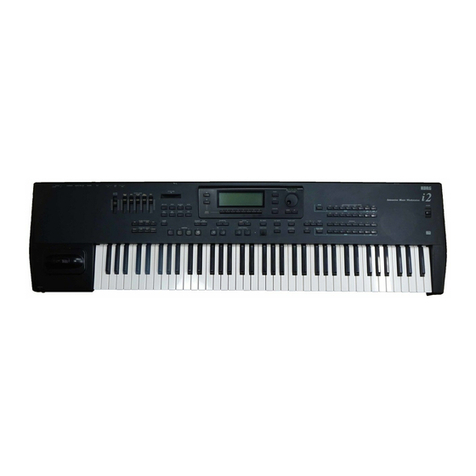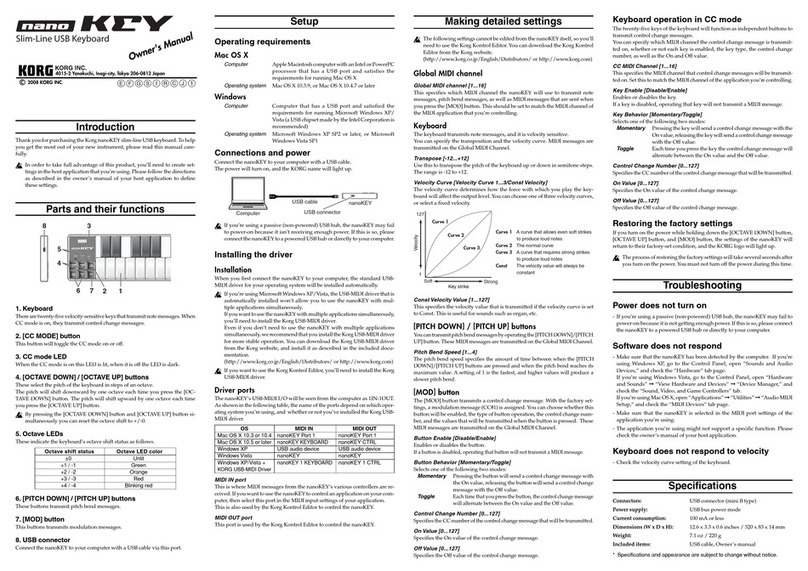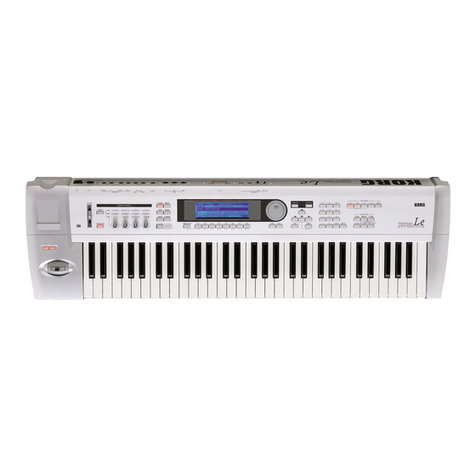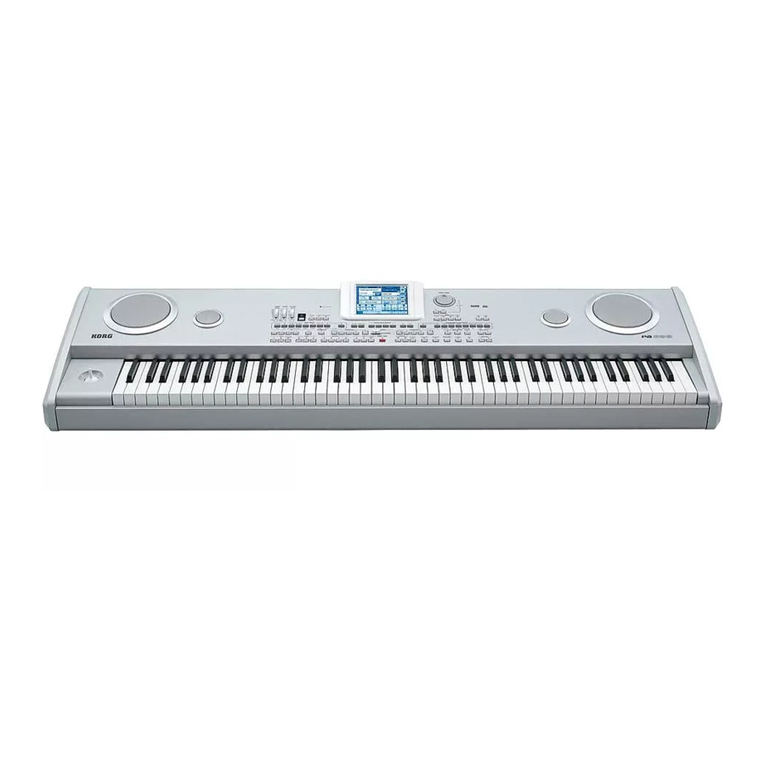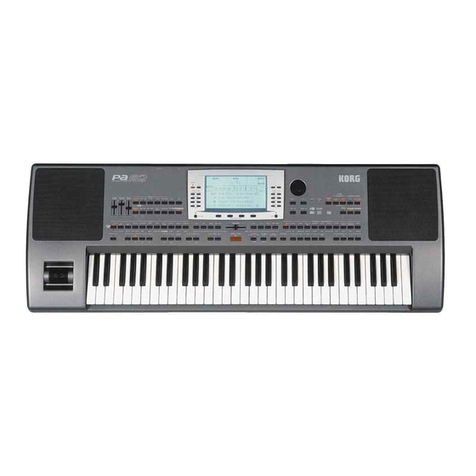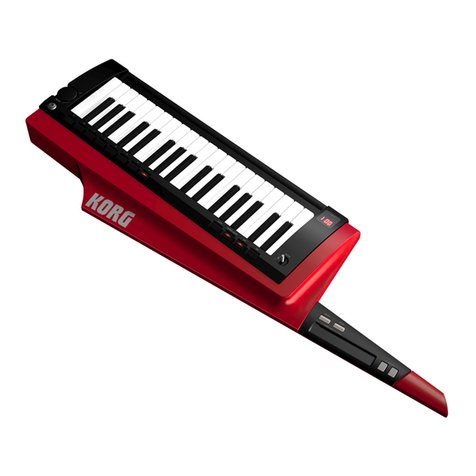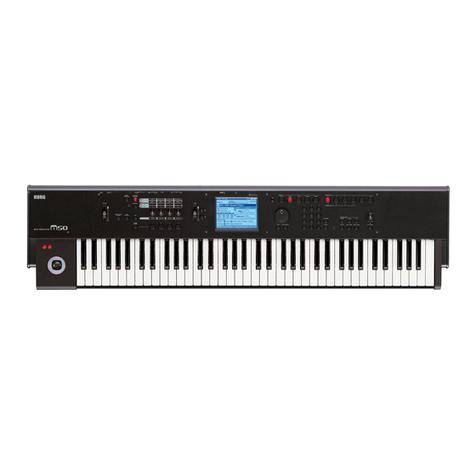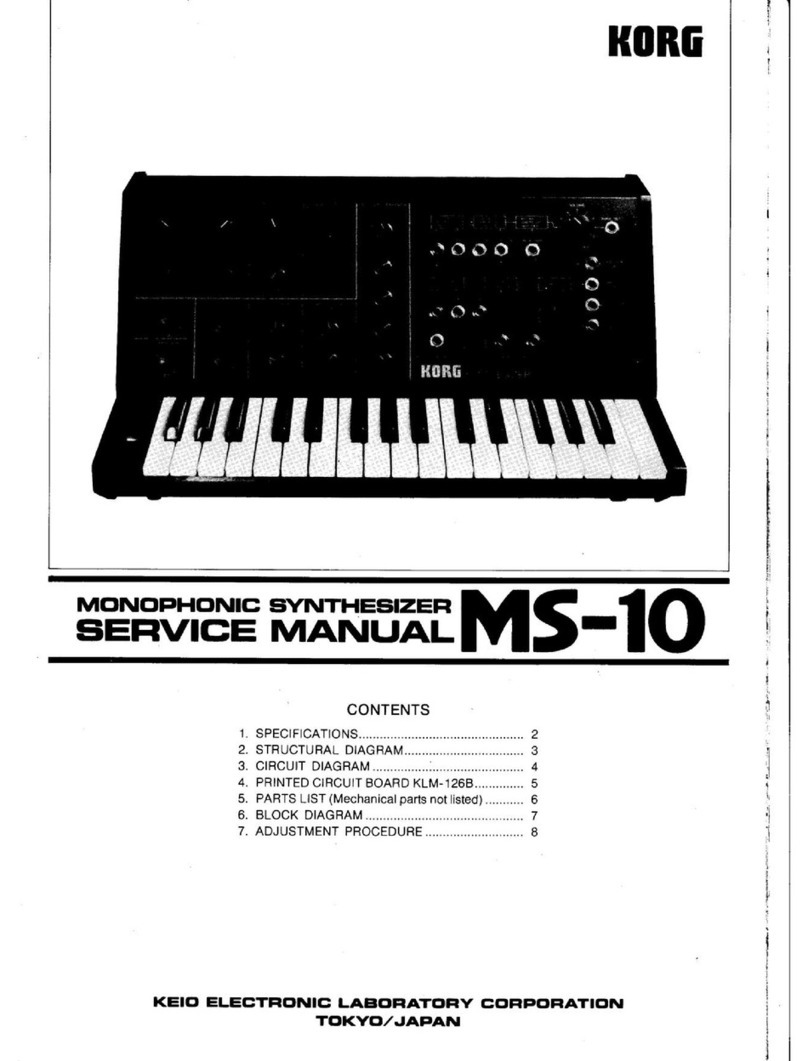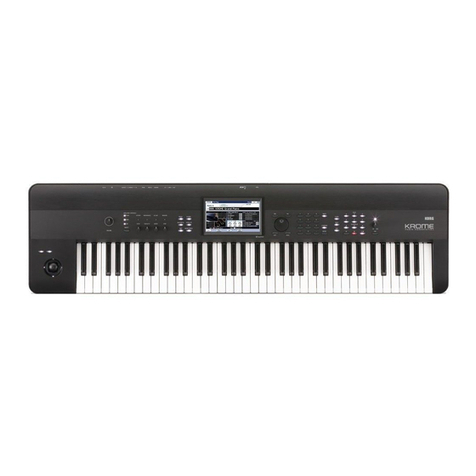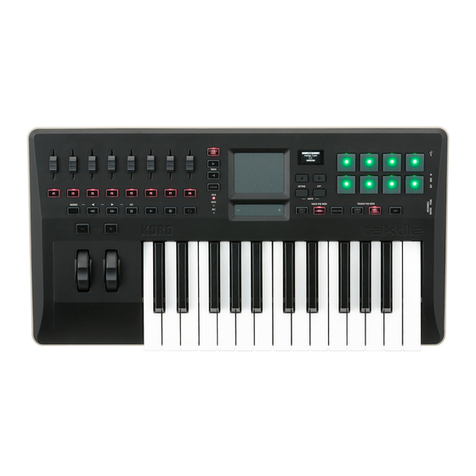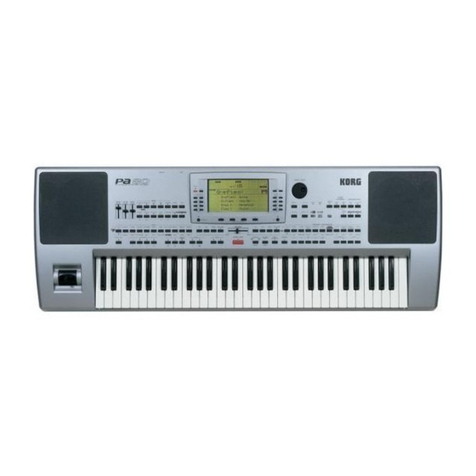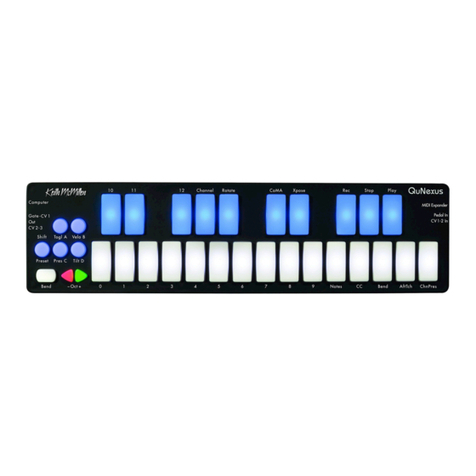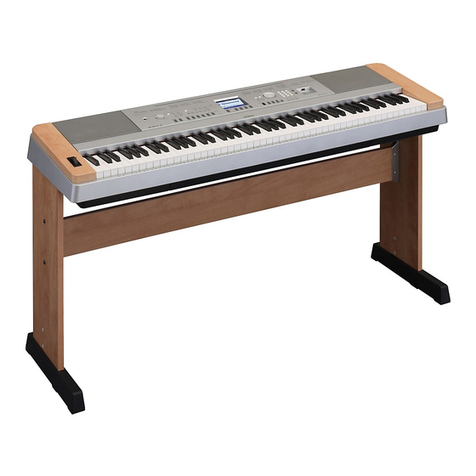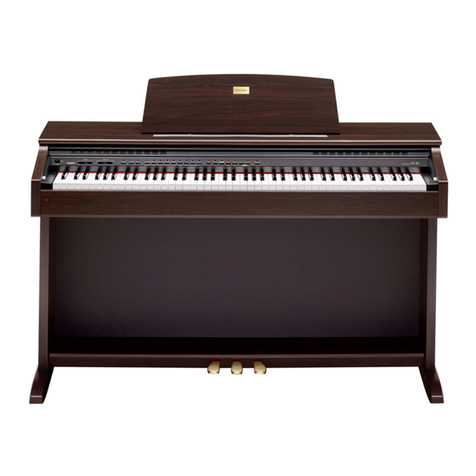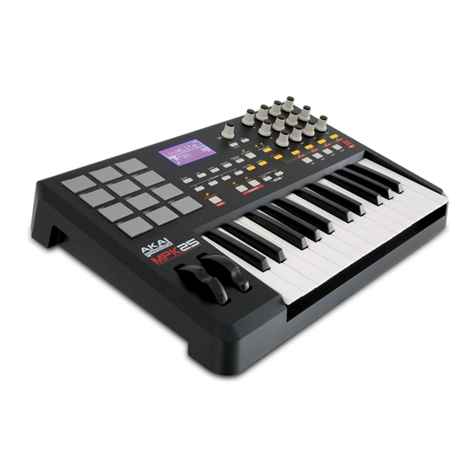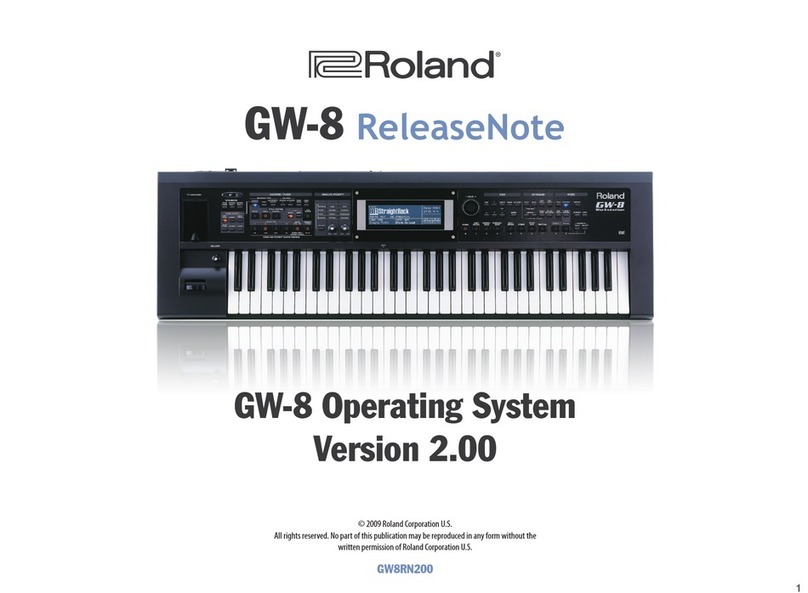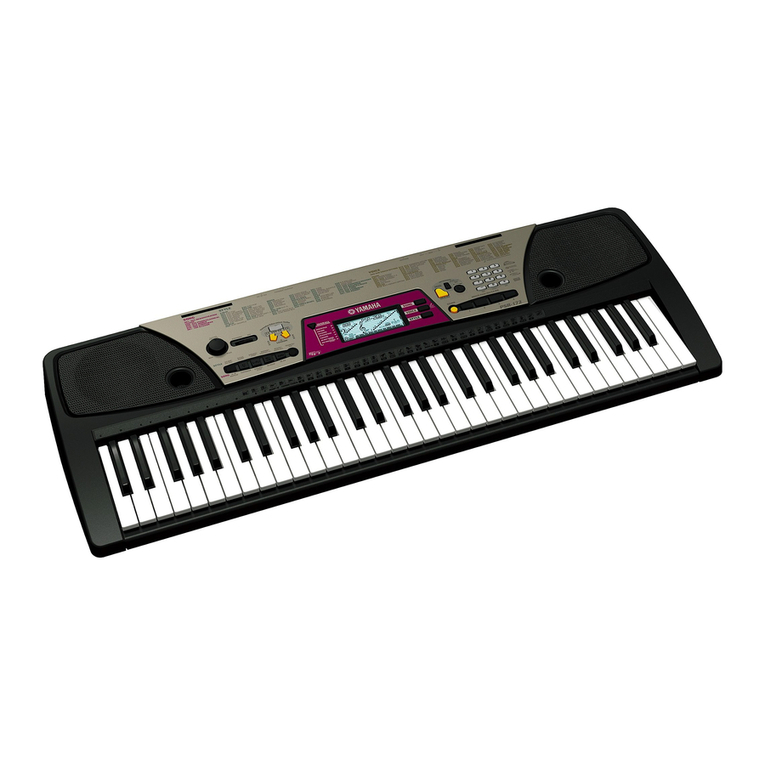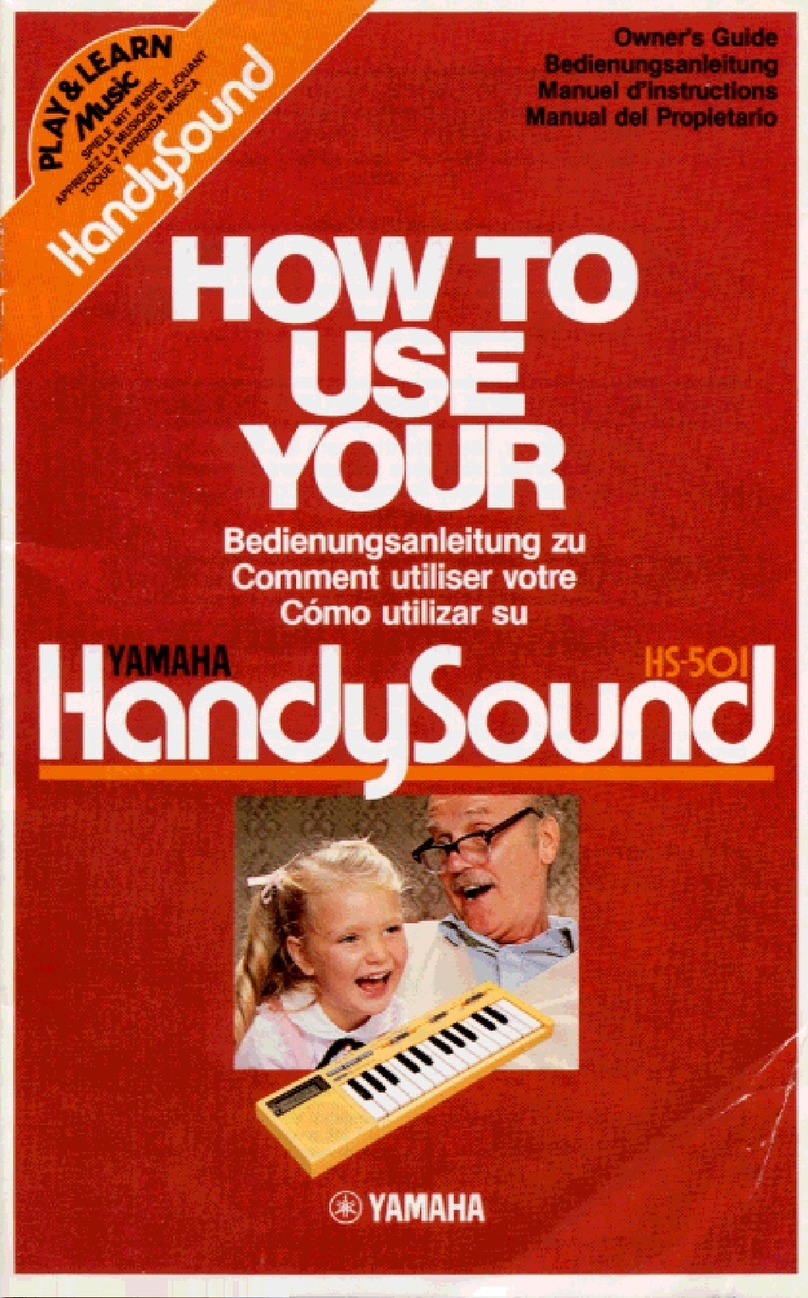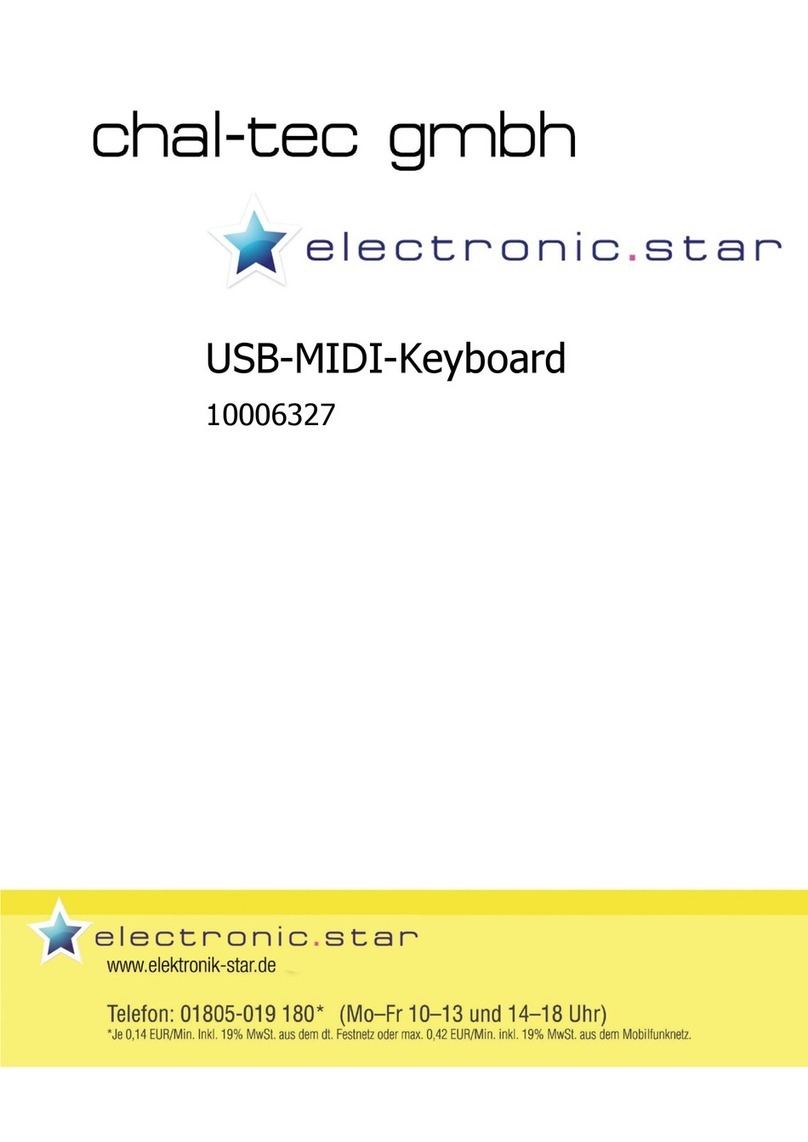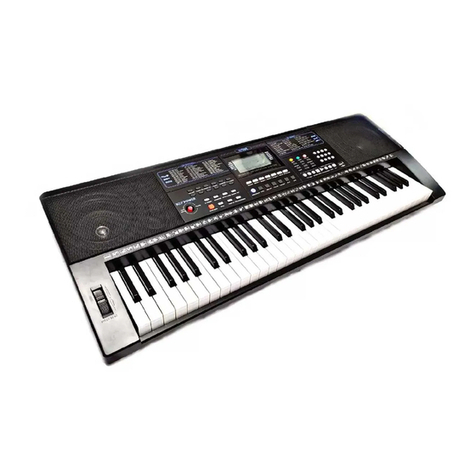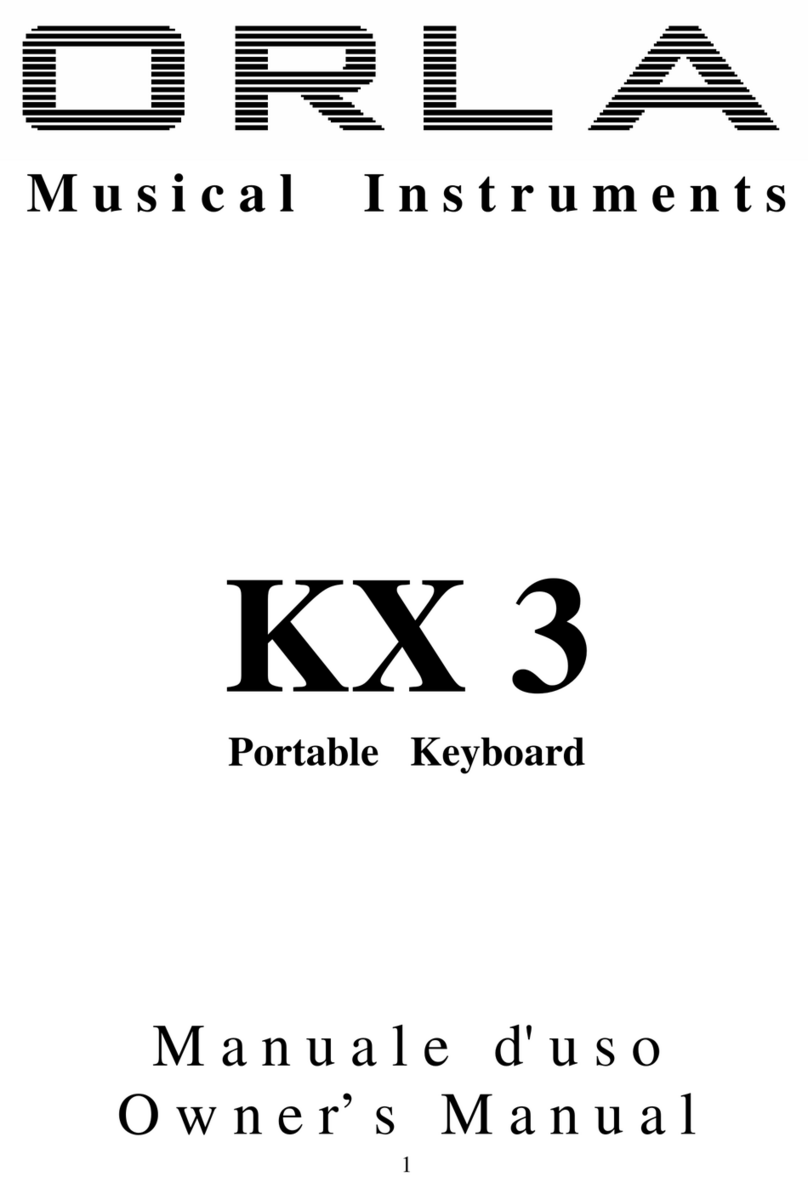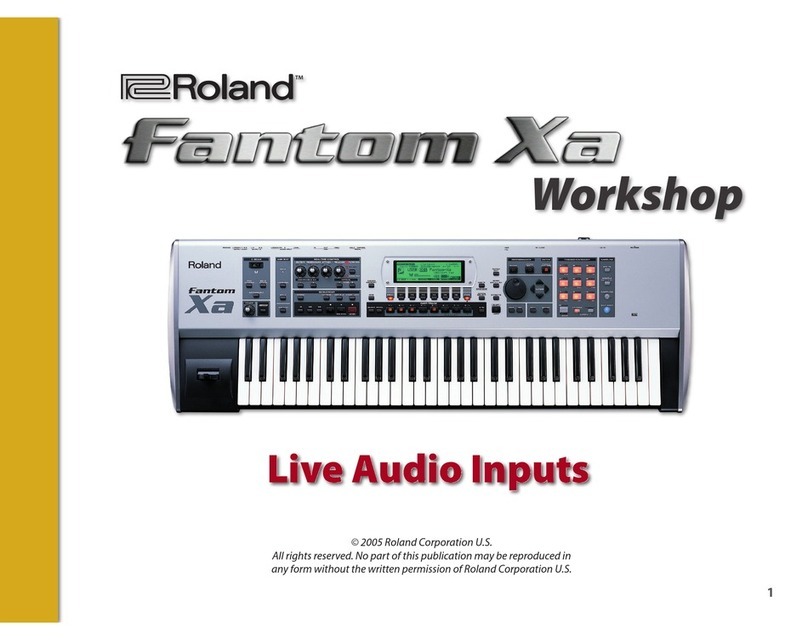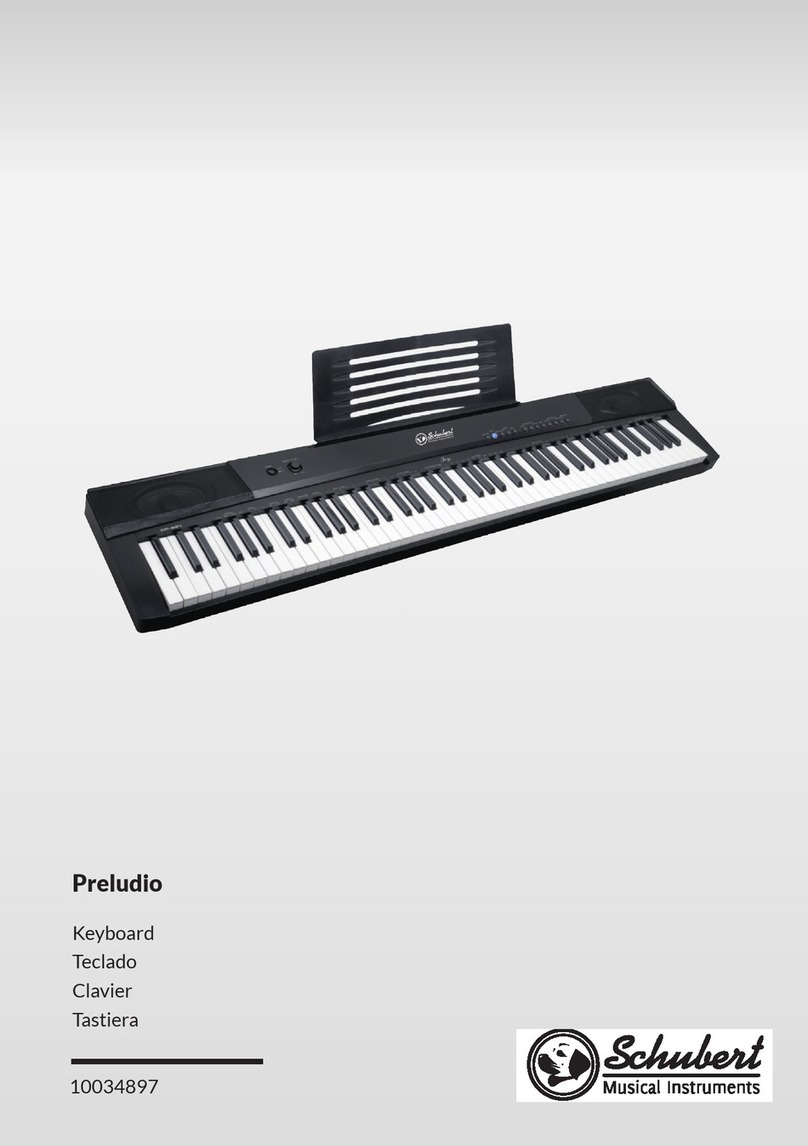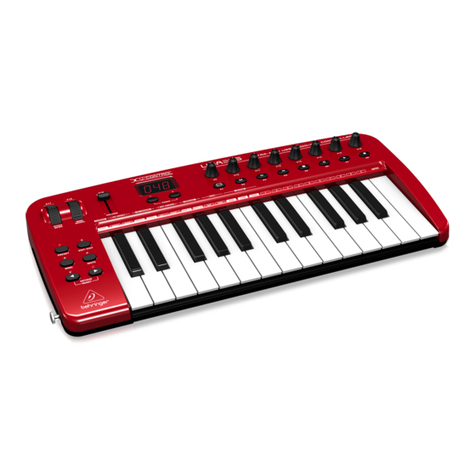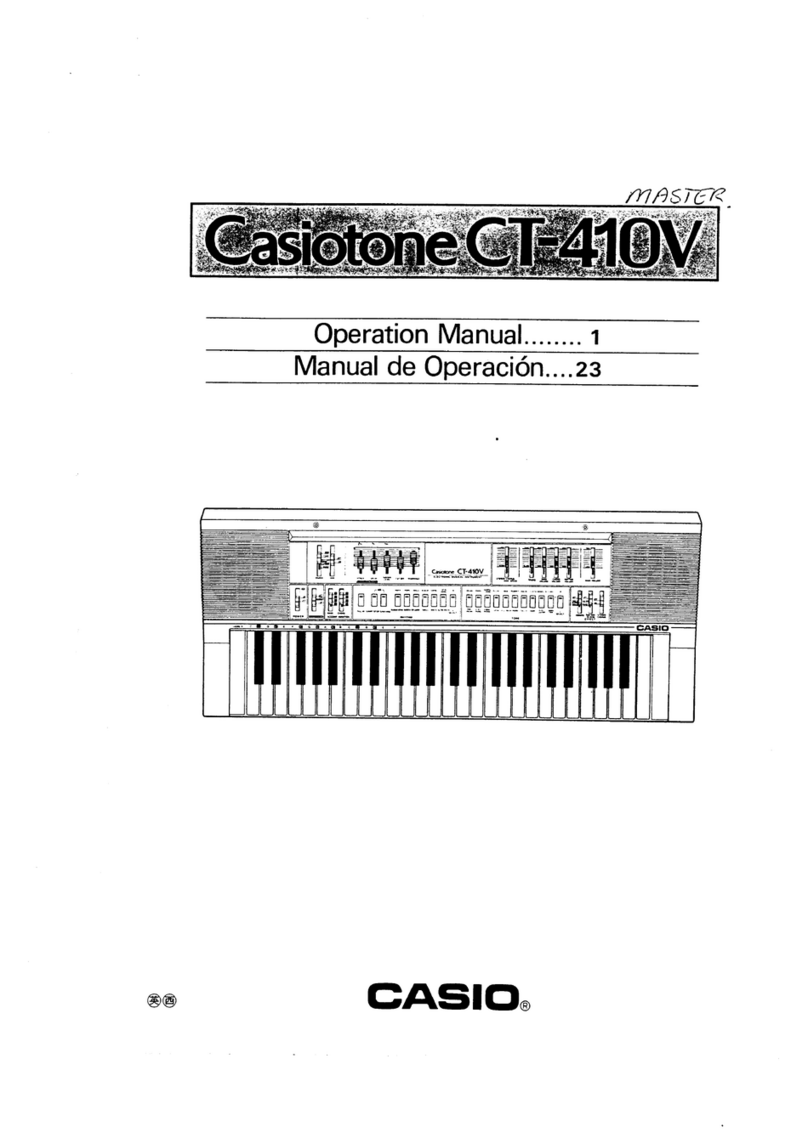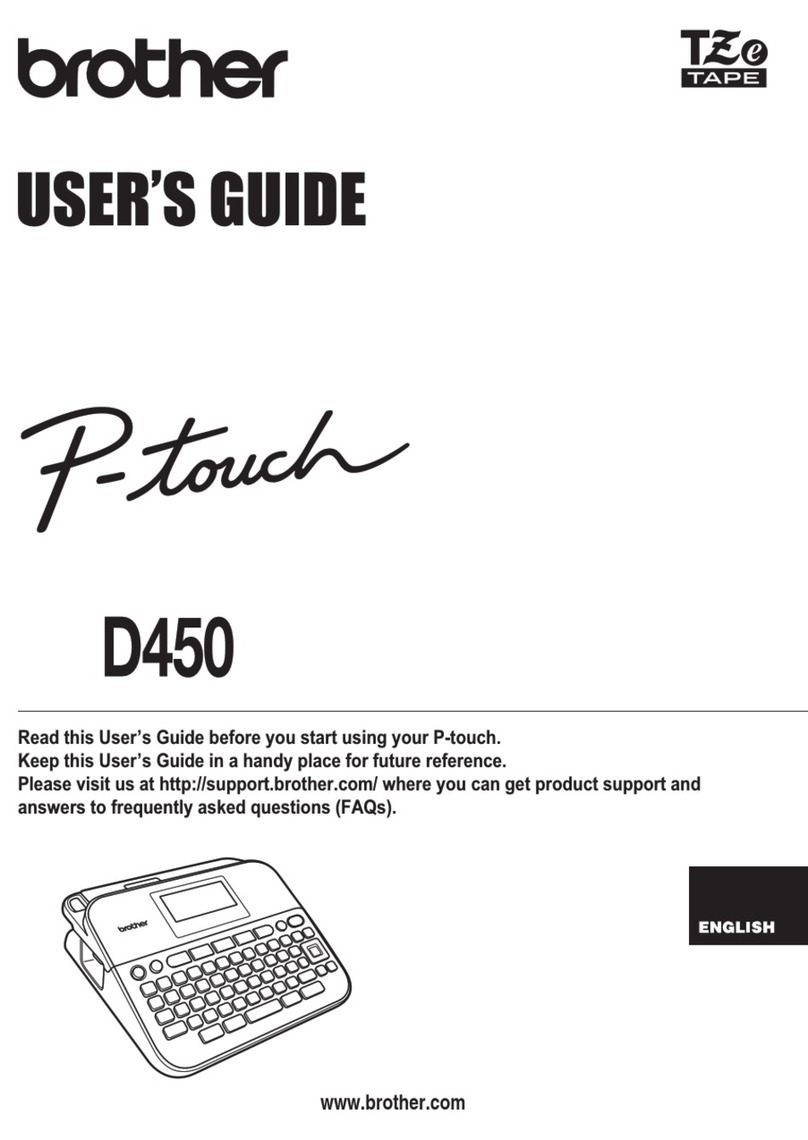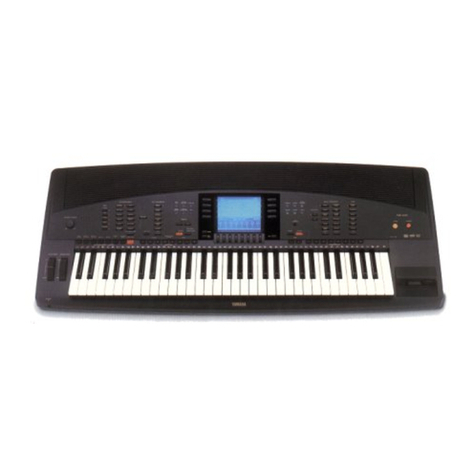Korg Karma Instruction Manual

- 2 -
Table Of Contents
Last Revised On: 12/18/2001
Total Topics = 165
Section 1: General, Global, Drum Kits, Miscellaneous (23)......................3
Section 2: Karma vs. Triton (3)...............................................................12
Section 3: MIDI – Transmitting, Receiving, SysEx (13)...........................15
Section 4: Program Mode, Programs (6)..................................................23
Section 5: Combination Mode, Combis (13)............................................26
Section 6: Sequence Mode, Sequencing, RPPR, Patterns (48).................33
Section 7: Disk Mode – Loading, Saving (5)............................................63
Section 8: KARMA Function (26)............................................................66
Section 9: Generated Effects, GEs (6).....................................................83
Section 10: Expansion Boards (EXB, MOSS) (9).....................................87
Section 11: Sync (4) ...............................................................................91
Section 12: Insert/Master Effects (IFX/MFX) (7)....................................93
Section 13: Using Karma For Live Performance (2).................................98
(Click on the section titles above to go directly to the desired section.)

- 3 -
Section 1: General, Global, Drum Kits, Miscellaneous (23)
1. Several programs or combis have an odd “dirty” or “crackling”
sound to them. Example Combis are A049, A082, & E033.
These are “supposed” to sound dirty in this way. Why? Some people
actually like this! If you go to (7.2/7.3) [Menu] -> [IFX] or [MFX], you will
see that somewhere there is an Insert or Master Effect called
“St.AnalogRecd.” This means “Stereo Analog Recording,” and it is
supposed to make snaps, crackles, and pops as if this was a sample
taken from a vinyl record. As you know, taking samples from records
was (is?) wildly popular for certain types of music, so this simulates the
effect quite nicely. All you have to do to get rid of this is go to that Insert
or Master Effect and turn it off, then resave the Combi or Program.
2. How do I access individual Drum Samples, or edit Drum Kits?
You change the individual samples of drum kits in the Global mode, so
you can, for example, listen to individual snare drums or kick drums.
(1) Select Program A004: !{Tricky}Kit !
(2) (5.1) (Global)->[Menu]->[DKit]
(3) Here you can view/edit which Drum Sample(s) are assigned to each
key of the Drum Program. Tip: to easily select a certain key’s drum
sound, cursor so that the Note Number is highlighted (the field directly
under the keyboard to the far left, i.e. ‘C3’), press and HOLD the ENTER
key, and play the note that you wish to edit.
Note: Any changes you make here affect all programs that may use the
Drum Kit that you have edited. And these changes will disappear when
you turn off the Karma UNLESS you use “Write Drum Kits” from the
[Utility] menu.
☞Parameter Guide pages 142-144.
3. Is there a way to navigate around the Karma interface faster?
You can jump to any page by holding down the menu key and pressing 2
numbers on the numeric keypad. The numbers correspond to the Page
and subpage, as displayed in the main [MENU] pages. If you just learn to
picture the Menu window in your mind (which is fairly similar between
Program, Combi, and Sequencer Modes), it’s easy to learn that the Karma
parameters (for example) are column 6, and the DynMidi (for example) is
on [K RT] page (which is number 4 in column 6), so to get there quickly
from anywhere just hold down [MENU] and type “64”. Or the Insert FX

- 4 -
parameters are in Column 7, number 2, so just hold down [MENU] and
press “72”. Note that this also corresponds to the whole organizational
scheme of the Manual (Page 6.4.x etc.)
In Global Mode, you only have to use 1 number, because there is only 1
page per column. In other words, hold [MENU] and press 1, or hold
[MENU] and press 2, etc.
☞Basic Guide, Page 14.
4. What version of software (OS) in my Karma?
Watch the display as you turn it on. The software release number is
displayed under “KARMA Music Workstation” at the bottom of the
screen, next to KORG.
OS Software releases are available from Korg USA, Korg Germany, Korg
Japan, and other distributors on their web sites. There are also complete
instructions on how to install it, in the applicable language. There are
direct links on my site at:
http://www.karma-lab.com -> [Specs, Manuals & Updates]
5. My Karma crashes/freezes on start up!
You may have attempted to load corrupted .PCG data, or some other
similar problem. In any event, you can solve this problem by resetting
your Karma:
1. Turn off your Karma.
2. Reset Internal Memory by holding both the [MENU] and [9] keys
down, while turning the Power On. You will see “Now writing Into
Internal Memory”. Then you can release the keys. Note: THIS
ERASES ALL INTERNAL DATA.
3. Reload Preload.PCG from the Preload floppy disk which is included
with KARMA, or reload your own data from your backup floppies (you
do have backups, of course, right? ;-)
6. What is a timbre?
A timbre is a word that essentially means “separate tone color”. It is
fairly commonly used interchangeably with “instrument,” “program,” etc.
It is also the word used to describe the 8 “tracks” that are available in a
Combi, in order to differentiate the fact that you can’t actually record

- 5 -
anything in Combi Mode (Combi Mode has 8 timbres, Sequencer Mode
has 16 tracks.) ☞Basic Guide, Page 52.
7. Weird problem: nearly every Combi seems to be changed – but
just on one track. For example Combi B000/KARMA HipHop
should have Prog B017 on timbre 4 - but it shows Prog B000.
It seems that you have a MIDI routing problem. Unplug any MIDI
cables - does it still happen? You are probably sending a program
change back thru to yourself (i.e. you change to Combi A025, and
suddenly any timbres that are set to the Global MIDI Channel change to
Program A025.) Note: this could also happen in Sequencer Mode.
With a properly set up MIDI system, this should not be happening – but
this is not the fault of the Karma. Something in the way you are routing
your gear is causing a “loop” problem.
Try going to Global and turning off the ability to change Programs and/or
Combis via program change messages. This is a temporary fix, but
should solve your problem until you figure out where the echoing
through is happening.
(2.1-1a) (Global)->[MIDI]-> Enable Program Change OFF
☞Parameter Guide, Pg. 137.
8. I have heard that certain early units had a noise problem. How
do I know if I have it?
Yes, certain “early” units had a bad IC chip that caused crackling at the
ends of certain waveforms. While Korg has explained that this cannot be
narrowed to a specific serial number range, it is my opinion that “early”
means serial numbers before 000650. Try this simple test:
Select Program A004 Tricky Kit. Play the F or the G below Middle C, and
hold the note. As the sound dies out, if you hear a DEFINITE LOUD
CRACKLING, then your unit is affected. Anything that is not actual
crackling, then you don’t. In other words, don’t turn your volume WAY
UP and start to imagine that some tiny perceived noise at the end of the
sample (which happens on many waveforms, due to the limitations of
sampling in 16 bits) is the problem, when it isn’t. If you have it, you will
DEFINITELY KNOW IT when you do the above test. Otherwise, you’re
fine. If you have to turn your system up to 11 as the sound is dying out
and then you think you *might* hear something, you don’t have it.

- 6 -
Korg will fix this for you for free, if you have the problem. Contact
customer support at 1-800-645-3188.
DO NOT confuse this with programs that are *supposed* to have noise,
such as A49, A82, & E33. These use an effect to simulate the crackling of
a vinyl record. See elsewhere in this FAQ for more info.
9. When I plug any of my standard sustain pedals in, nothing
happens.
Are you plugging it into the jack labeled “Damper”, and not “Foot
Switch”? Any standard momentary type foot switch will work. The only
thing is that some foot switches have the polarity reversed. If you get
sustain when you let off, and no sustain when you press down, it’s
backwards. You can switch this in:
(6.1-1) Global -[Menu]-[Ctrl]-[Foot]->Damper Polarity
☞Parameter Guide, Page 145.
10. Why do some Programs or Combis have the sustain pedal
disabled? The A001 AcousticPianoAT patch is a good example.
The reason is that the programmer of the patch decided that when
KARMA is active, the use of the sustain pedal caused objectionable
behavior. Or, the sustain pedal is programmed to do something else (like
activate the Note Latch function in Dynamic MIDI).
In the case of A001, I wrote this patch, and I agree in retrospect that the
sustain pedal should be active. I didn’t like certain things you could
make it do with the KARMA function active, but now I believe that it is
more normal with it functioning normally. Fortunately, it is easy to
change:
(6.1-5) [Menu]-[KARM]-[RxFilter] -> Damper CC#64 -> set to On.
☞Parameter Guide, Page 60.
Here, in A001, we can see that “Damper” (CC 64) is OFF. This means
that when KARMA is ON, the Damper will not be echoed through (and
therefore will not work). Set this to ON and resave the Program, and it
will work in a more normal fashion.
In a Combi, it is a similar operation, except you can control the Damper
for each KARMA Module separately.

- 7 -
Note that changing this setting doesn’t always change the damper
operation, because this particular setting only affects what happens
when KARMA is ON. If the Damper is disconnected when KARMA is OFF
(also), then you must go to another place:
(4.1-2a) [Menu]-[MIDI2]-[MIDI2-2] -> Damper CC#64.
☞Parameter Guide, Page 55.
Also note that if you are doing this to a Program or Combi, you should be
aware that the Damper may be assigned in the Dynamic MIDI section to
perform some other operation. You should check this and make sure
there is not a conflict - you may want to remove the Damper from
Dynamic MIDI in this case:
(6.4-3) [Menu]-[K RT]-[DynMIDI]-> Source -> locate Damper CC#64.
☞Parameter Guide, Page 63.
11. I have my Karma’s headphone jack hooked up with my
computer’s microphone jack when I record to computer.. yet my
songs don’t sound really stereo.
You really DON’T want to use the headphone output and the Mic Input to
record professional sounding audio. This is a decidedly Lo-Fi approach.
You want to use the L/R Audio Outputs on the Back, or the L/R outputs
of a mixer, and run them into a mixer or the L/R audio in on a computer
sound card.
Anyway, you probably *could* use the headphone out (but the Signal To
Noise ratio and harmonic distortion are not as good as the back outputs),
but if you are only getting one side, or weird cancellations, then you are
probably not making correct contact with the pins of the headphone jack.
Or you do not have the correct cable. The headphone Jack is a stereo
T/R/S (Tip/Ring/Sleeve) - if you are not using a stereo T/R/S cable, you
will only get one side - or worse, a weird kind of phase-inverted sound.
12. I am using another keyboard to play my new KARMA keyboard
(through MIDI). I’ve noticed that the other keyboard doesn’t
produce the same intensity as that of actually playing the
KARMA keyboard.
Different keyboards, especially older ones, send out the velocity of notes
over different ranges. You can adjust this somewhat by changing the
Karma’s Velocity Curve. Global (1.1-1) [System] -> Velocity Curve.
☞Parameter Guide, Page 134.

- 8 -
But first, you must change the “Convert Position” (2.1-1a) [MIDI] Convert
Position -> Post MIDI. ☞Parameter Guide, Page 138.
When Convert Position is “Pre MIDI”, the curve applies to the Karma’s
keyboard, and data from an external keyboard uses curve 4. When
Convert Position is “Post MIDI”, the external keyboard uses the selected
curve, and the Karma keyboard uses curve 4.
Try one of the higher number curves with your other keyboard.
Alternately, most keyboards have this sort of adjustment, and you could
try a different curve on the transmitting keyboard, rather than the
Karma.
13. When upgrading your OS, do you have to go in sequence (eg.
1.01, 1.02, etc.) or can you skip to the most recent?
You can go directly to the latest update, without performing the ones in
between. Whichever OS you load will be the one that your Karma is
running. You get the benefit of all the updates in between.
14. My Karma came with different PRELOAD Combis than in the
Documentation! I think the documentated Combis are on the
Disc which came together with Karma.
From your e-mail address, it seems you are in Germany. In Europe,
many of the distributors released the Karma with a re-ordered version of
the Combis. In other words, same Combis, different order. They felt they
wanted to put more dance-oriented Combis first.
You can use either order, but if you want it to match the Voice Name List
documentation, you should use the original order, on the Factory Preload
Disk. You could save the current order to disk first, and then you will
have both. Or, see:
http://www.korg-karma.de/ -> Updates -> Factory Presets
15. Is there a way to adjust the darkness of the display?
Sometimes it seems a bit whispy or too dark.
I’ve noticed that the display contrast seems to change a little bit,
depending on how long the unit has been turned on. In any event, you
can adjust the amount of “darkness” to the pixels by changing the
contrast setting in Global (1.1-2) [Prefs]. ☞Parameter Guide, Page 136.

- 9 -
16. When I hook up the Karma with MIDI Cables to my PC, none of
the combis or programs play, just a bunch of popping and
cracking...
You probably have a MIDI Loop going on.
In other words, you are sending MIDI from the Karma into the PC,
sending it back into the Karma, which then sends it into the PC, which
then sends it into the Karma, etc. - this makes MIDI devices very
unhappy, and tends to make them appear to “lock up”, or sputter with
weird noises.
Unplug your MIDI Cables completely. Power down the Karma, then turn
it on again. Does everything work fine? Then this is your problem.
I can’t tell you exactly how to get rid of it (different PCs and PC
Sequencing Programs react differently), but you must either turn off
some sort of “Echo MIDI” or “Keyboard Thru” setting on your PC, or try
turning off “Local Control” in the Karma Global Mode (2.1-1).
17. How can I tell which Drum Sample is on a particular key?
To determine which Sample is on a particular drum key, you can go to
Global (5.1) [Menu]-[DKit]. Select the Drum Kit you want, then hold the
[ENTER] Key and play a note. The display switches to display the data
for the note that you just pressed. The Multisound (sample) number is
displayed near the bottom of the screen, i.e. “305 Cowbell 1”. Don’t
forget, a single key can have 2 different drum samples, and a velocity
switch point (High/Low tabs).
18. Is there a way to clear an entire bank of Programs or Combis
(or Initialize a single Program or Combi)?
Yes. Load an empty bank of Programs or Combis. If you have filled all
your banks and never backed up a copy of an empty bank, you can
download a completely empty PCG file from my site, and use it to load
single INITIALIZED Programs or Combis, or entire banks. See the Disk
Mode Section of this FAQ for info on loading single Programs/Combis or
single Banks. The INIT file is located on this page:
PC: http://www.karma-lab.com/Files/INIT.zip
Mac: http://www.karma-lab.com/File/INIT.sit.hqx

- 10 -
19. Why are the banks and the programs in them in that particular
order? Wouldn’t it be more straightforward to have one bank be
one category of sounds?
There are typically (2) methods keyboard manufacturers use to arrange
sounds in a keyboard:
(1) By categories (i.e. 32 piano/org first, then 32 guitars, then 32 basses
etc.)
(2) Presented so as to show the diversity of sounds in the keyboard, with
some sort of other logic.
The reason some companies (Korg included) use #2 is that when people
go to audition a keyboard (to decide to buy it), they typically start at
program/combi 0, and increment through each program, to the next, to
the next, etc. If you’ve only got 10 minutes to check it out, it makes far
more sense (from a marketing viewpoint) to present a variety of sounds
than just one variation of piano after another.
In Korg’s case, the “other logic” is that there are 16 “categories” of
programs, so every 16 numbers, 1 from each category is presented. In
other words, A000 is from the “Fast Synth” category, so is A016, A032,
etc. A005 is from “Guitar/Plucked”; so is A021, A37 etc. This is easy to
see if you use the Voice Name List.
Note that in order to help (and compensate) for this arrangement, Korg
has the “Select by Category” UTILITY in nearly every Mode. If you are
looking for just guitar programs, use “Select By Category” to search just
the “Guitar/Plucked” category. You can even audition different programs
right from the Select By Category Dialog without closing it. You can also
use the “Category Hold” function in Program and Combi modes (bottom
right button of 9-key keypad area) to “lock” the category and then just
use the Value Up/Down keys to advance to the next Prog or Combi in a
category.
20. Can I make my keyboard “wake up” the next day with the
same thing I was working on last night?
Global (1.1-2) [Prefs] Power On Mode. ☞Parameter Guide, Page 136.

- 11 -
21. Can I program microtonal scales and alternate tunings on the
Karma?
Yes, you can create/edit up to 16 “User Octave Scales” (where you
specify the tunings for a single octave, and it is applied to all octaves the
same way), and 1 “All Notes Scale” (where you can individually tune
every single note of the keyboard.) ☞Parameter Guide, Page 140.
However, to hear what you are editing, you have to set the program to
use the scale you are editing. Try this experiment:
- Select Program A001: Acoustic Piano. Turn the KARMA function Off.
- Go to (2.1-1c) [Basic] [Basic] -> Scale Type: set to “User Octave 00”.
- Go to Global (3.1-1) [U.Scl][Octave]. Select User Octave 00, and edit
one of the tunings, say on the C - crank it up. Now play the keyboard
and all of the Cs are “out of tune”.
Using the “All Notes” scale type is great for creating the sound of a piano
that hasn’t been tuned in 15 years :-)
22. Is it possible to map the individual drum samples shown in the
Voice Name List to specified keys within the Karma
environment?
It’s totally possible. You just have to do it within a Drum Kit. A Drum
Kit is a special map where you can specify samples for every key. This is
done in the Global Mode, (5.1) [DKit] ☞Parameter Guide Page 142.
There are 64 Drum Kits available, saved in several different Banks. Note
that when you edit/create a Drum Kit, you then need to use it inside a
Program to actually “hear” it. In other words, start with one of the other
Drum Programs and change the Drum Kit to use the one you are editing,
then go to Global Mode to edit it. Program (2.1-1) [Basic] Osc Mode ->
Single, Double, Drums. ☞Parameter Guide, Page 7. After editing a
Drum Kit, it will go away when you power down unless you “Write Global
Settings” (1.1-1d) UTILITY, ☞Page 135.
23. Can you play the samples stored in the KARMA in reverse ?
Program Mode (2.1-2b, 2.2-2b) [Osc1/Osc2] -> Rev (High Reverse).
If you checkmark the “Rev” checkbox, it will play the samples of the
multisound in reverse. ☞Parameter Guide, Page 8-9.

- 12 -
Section 2: Karma vs. Triton (3)
1. Are Triton Files compatible with the Karma?
Yes. You can load Triton Combis, Programs, and Sequences into the
Karma. The Karma ignores the settings for the Triton arpeggiators,
because Korg built it after the Triton, and it knows to ignore these
parameters.
2. Are Karma Files compatible with the Triton?
No. You cannot load any Karma files into the Triton. Because Korg built
the Triton before the Karma, it doesn’t know anything about ignoring all
the extra KARMA parameters that are in the data. If you created a
sequence in the Karma, you could export it as a standard MIDI file and
import it into the Triton, but there’s no way to load in the Song definition
itself.
3. What is the same, and what is different about the Programs and
Combis in the Triton and the Karma?
The Karma A & B Program Banks are identical to the Triton’s, with the
exception of some very minor tweaks to Insert/Master FX (sometimes
allowing them to be modulated by KARMA), but no real changes to
Program data, because that would make them incompatible with EXB
Boards. Also some minor name changes to indicate certain KARMA
features. The Karma E Bank is a combination of selected Triton C & D
Programs, and a few new ones used by the demo sequences.
Many Triton users apparently complained about having to overwrite their
user banks when loading EXB boards, so we decided to leave C & D
empty in the Karma to avoid this problem. That is why the Karma ships
with Prog/Combi banks A, B and E loaded, and C & D empty.
The Karma Combis are nearly all completely different. Some may have
started out as ports of a Triton Combi, but even ones that have the same
name as a Triton Combi have been rewritten to use KARMA, therefore
many things have been changed, including timbres, effects, etc.
The Karma can load Triton Programs and Combis - fully compatible - the
only thing you lose are the Arpeggiator settings. So you can keep your
Triton disks, or find Triton sound data on the internet, and load nearly
anything you want into the Karma.

- 13 -
The following chart shows the differences between the Triton and Karma
Preload data, and also what is available to be loaded from an Expansion
Board floppy disk. Please keep in mind that the EXB Expansion Boards
have a floppy that was created for the Triton; to load the data into the
Karma, you must load separate banks of Combis and Programs rather
than loading the entire .PCG if you want to keep your Karma data intact.
This is explained elsewhere in this document.
PRELOAD
Programs Triton Karma
Bank A Same, except for slight EQ, effects and name
changes. Uses KARMA GEs instead of Triton
Arps.
Bank B Same, except for slight EQ, effects and name
changes. Uses KARMA GEs instead of Triton
Arps.
Bank C Empty. Some Bank C Programs are in Karma
Bank E.
Bank D Empty. Some Bank D Programs are in Karma
Bank E.
Bank E (Empty) Combination of selected Triton Bank C & D
Programs, along with a few new ones. Uses
KARMA GEs instead of Triton Arps.
Bank F (MOSS option) Same, except no Arpeggiator or GE
assignments.
Combinations Triton Karma
Bank A New/Different – uses KARMA GEs instead of
Triton Arps.
Bank B New/Different – uses KARMA GEs instead of
Triton Arps.
Bank C Empty
Bank D Empty
n/a New/Different – uses KARMA GEs instead of
Triton Arps.
n/a Empty
Note: any Triton Arpeggiator settings will not be available with the Karma.

- 14 -
EXB - PCM 001-005 (1 board, 128 new Programs/Combis)
Programs
Bank A – Triton Preload Bank A (Inside C_Bank.PCG & D_Bank.PCG)
Bank B – Triton Preload Bank B (Inside C_Bank.PCG & D_Bank.PCG)
Bank C – 128 New Programs for EXB (Inside C_Bank.PCG)
Bank D – Same as Bank C above, for loading convenience (Inside D_Bank.PCG)
Combinations
Bank A – Triton Preload Bank A (Inside C_Bank.PCG & D_Bank.PCG)
Bank B – Triton Preload Bank B (Inside C_Bank.PCG & D_Bank.PCG)
Bank C – 128 New Combis for EXB (Inside C_Bank.PCG)
Bank D – Same as Bank C above, for loading convenience (Inside D_Bank.PCG)
Note: any Triton Arpeggiator settings will not be available with the Karma. There are currently no
GEs assigned to any Programs or Combinations.
EXB - PCM 006 (Orchestra – 2 boards, 256 new Programs/Combis)
Programs
Bank A – Triton Preload Bank A
Bank B – Triton Preload Bank B
Bank C – 1st 128 of 256 New Programs for EXB
Bank D – 2nd 128 of 256 New Programs for EXB
Combinations
Bank A – Triton Preload Bank A
Bank B – Triton Preload Bank B
Bank C – 1st 128 of 256 New Combis for EXB
Bank D – 2nd 128 of 256 New Combis for EXB
Note: any Triton Arpeggiator settings will not be available with the Karma. There are currently no
GEs assigned to any Programs or Combinations.
EXB - MOSS (1 board, 128 new Programs, 64 New Combis)
Programs
Bank A – Triton Preload Bank A
Bank B – Triton Preload Bank B
Bank F – 128 New Programs for MOSS
Combinations
Bank A – Triton Preload Bank A
Bank B – 000~063: 64 new Combis using MOSS. 064~127: Triton Preload Bank B.
Note: any Triton Arpeggiator settings will not be available with the Karma. There are currently no
GEs assigned to any Programs or Combinations.

- 15 -
Section 3: MIDI – Transmitting, Receiving, SysEx (13)
1. How do you send the MIDI data from KARMA to external devices
(or external sequencers)?
In Program Mode, MIDI Data from KARMA is automatically sent out the
MIDI out port, on the Global Channel. Just hook up another synth set to
the same Global Channel and it works.
In Combi Mode, it is not possible to control both an external synth and
the internal sound on the same timbre at the same time. All of the
Combis default to having the Internal Sound playing (of course). To send
MIDI data to an external device in Combi mode, choose (3.1-1) [Menu] ->
[Prm1] -> [MIDI], and change the Status Field of one or more timbres
from “INT” to “EXT”. You can have some of the KARMA Modules playing
the INTernal sounds from the Karma, and some of the KARMA Modules
playing the EXTernal sounds. ☞Parameter Guide, Page 49.
(Trick: if you DO want a KARMA internal sound layered with an external
sound in Combi Mode, let’s say you want the bass line to use the Karma
sound, and then layer it with another bass sound from some external
device, you can do it by finding an open Timbre (one that is set to Status
“OFF”), and set it to the same MIDI channel as the timbre that the bass
is on. Then set the Status of this timbre to “EXT”, and you will have 2
timbres listening to the bass MIDI Channel, one of them playing the
internal sound, and one of them sending MIDI to the external device. Or
see Sequencer mode below.)
In Sequencer Mode, simply use “Copy From Combi” with Effects checked,
and then you can set the Track Status to “BOTH”, and the track will be
sending to the Internal and External Sounds at the same time. [Menu] ->
[Prm1] -> [MIDI...8] or [MIDI...16] ☞ Parameter Guide Page 82.
You can use Sequencer Mode as a sort of “Combi with external MIDI
capabilities” in this fashion, without actually recording anything (or use
this mode to send data to an external sequencer.)
2. How do I set the KARMA Knobs and Switches to generate MIDI
events, so I can record them into my (external) sequencer?
You can set all the knobs to generate MIDI CCs in the Global Mode:
(6.1-2/3) (Global)->[Menu]->[Ctrl]->[KARM1/2].
☞Parameter Guide, Pages 146-147, Basic Guide Page 104.

- 16 -
3. My MIDI activity light on my <insert interface> is always lit. It
seems that the Karma is always sending tons of MIDI data, even
when it is doing nothing!
What you’re seeing is MIDI clock, which is sent 24 times per quarter
note. The Karma sends this in all modes (except Disk mode) whether
KARMA is on or off. The only way to stop this is to put the Karma in
External Sync Mode (and then of course, nothing will work unless you
send it MIDI Clock from somewhere else).
This activity is actually harmless, and is in no danger of “clogging” your
interface. This will keep the light activated, but it is not at all a “flood” of
information; just a steady pulse that in no way causes any problems.
But one idea if this really bothers you: in OMS, for example, which is
what I use on my Mac, you can specify whether a certain instrument
sends/receives MIDI Clock. You may be using FreeMIDI or something
else, which I am not familiar with. But if you have that sort of feature,
and you don’t need to sync anything to the Karma, you can just “filter
out” the MIDI Clock from the Karma. Many interfaces have internal
options you can set to do this, also.
4. How do I access the different banks of programs using MIDI
program change messages, and bank change messages?
There are (2) ways to control program changes on the different banks. It
depends whether you want to run the KARMA in “Korg” mode or “GM2”
mode. Most users will probably want to set this to “Korg” Mode.
(1.1-2) (Global)->[Menu]->[Basic]->[Prefs]->Bank Map = Korg.
☞Parameter Guide, Page 136 for a complete description of how to send
bank changes for the two different modes.
5. I get incorrect patches changes when using MOTU Free MIDI
patch lists or Cakewalk Intrument Definitions, or just sending
program changes.
You have to set the “Bank Map” of the Karma correctly:
(1.1-2) (Global)->[Menu]->[Basic]->[Prefs]->Bank Map = KORG (not GM2).
Press [F8] -> Write Global Setting -> OK..

- 17 -
6. What does MSB and LSB refer to, for changing banks and
Programs and Combis via MIDI?
For those of you unfamiliar with changing banks (and programs) through
MIDI, there is more to it than just sending a Program Change Message.
A true program change that also selects a bank is composed of (3) MIDI
messages:
CC 000 nnn (Bank Select MSB - Most Significant Byte)
CC 032 nnn (Bank Select LSB - Least Significant Byte)
Prog Change nnn (MIDI Program Change message 0~127)
☞Parameter Guide, Page 136 for a complete description of how to send
bank changes for the two different “Bank Map” modes. Here’s a bit of a
rewrite, using “Korg” Bank Map Mode (which is what you should
probably use):
MSB (CC 000) LSB (CC 032)
Bank A 000 000
Bank B 000 001
Bank C 000 002
Bank D 000 003
Bank E 000 004
Bank F 000 005
Bank G(0) 121 000
Bank G(1) 121 001
Bank G(2) 121 002
Bank G(3) 121 003
Bank G(4) 121 004
Bank G(5) 121 005
Bank G(6) 121 006
Bank G(7) 121 007
Bank G(8) 121 008
Bank G(9) 121 009
Bank G(Drum) 120 000
So, in other words, to select Program D025 from an external sequencer,
you would send CC 000 “000” followed by CC032 “003” followed by
Program Change 025.

- 18 -
7. How do I play the Karma from another keyboard?
In Program Mode, the Karma responds on a single MIDI Channel, which
is set in Global Mode (2.1-1a) [Menu]->[MIDI]->MIDI Channel.
☞Parameter Guide, Page 137. You must set your other keyboard to
transmit MIDI data on this same Channel (consult your owner’s manual
for the other keyboard), and then connect the MIDI output of the other
keyboard to the MIDI input of the Karma.
In Combi Mode, the same basic rule applies. You must transmit from
the other keyboard on the Global Channel if you want to play the Combis
the same way that you would from the Karma keyboard. If you want to
play separate timbres (or tracks in the Sequencer), just set the other
keyboard to a particular Channel that you want to play.
When doing either of these, you may want to make it so that changing
programs on the other keyboard does not cause the Karma to change
Programs/Combis at the same time. This is accomplished using the
“MIDI Filter” settings in Global Mode (2.1-1b). ☞Parameter Guide, Page
138.
8. The Karma has 61 keys. If I MIDI an 88 note keyboard to the
Karma, will the Karma respond to notes outside its 61 key range
that I play on the 88 key controller?
Yes, the Karma will respond to all 128 MIDI notes. The only thing to be
aware of is that occasionally a programmer may have set the key zone
windows in a Karma Combi, or the Dynamic MIDI options, to specifically
relate to a 61 note keyboard. But if you run into cases like this, you can
go edit those things and change it so that it works with the full keyboard.
9. How can I change between Combis and Programs from my
external sequencer (Vision)? I have figured out which MSB/LSB
to use for the banks and programs but I can not find a control
number to switch between Combi and Program Mode.
To change actual Modes on the Karma, you need to use SysEx (not CCs).
The complete SysEx documentation can be downloaded from my site:
http://www.karma-lab.com -> [Specs, Manuals & Updates] -> MIDI &
Sysex Specification
The way that different sequencers deal with SysEx info varies, and can
be rather arcane. However, you’re in luck as Vision used to be my
sequencer of choice, so here’s how to do it in Vision:

- 19 -
In a track, in a List Edit Window, create a new “System Exclusive” event.
A window will open up, with an area for entering hexadecimal code. Type
the following (or paste) exactly as shown:
F0 42 30 5D 4E 02 F7
This changes the Karma to Program Mode.
F0 42 30 5D 4E 00 F7
This changes the Karma to Combi Mode.
Note that if your Global Channel is not 1, you would need to change the
third value, where the number is 3 followed by the (Channel - 1); in other
words, channel 1 is 30, channel 10 is 39, channel 16 is 3F (don’t forget,
this is hexadecimal).
Also note that you must enable SysEx in the Karma - by default, it is off.
Global (2.1-1b) -> Exclusive -> On. ☞Parameter Guide, Page 139.
10. How should I set my OMS Setup for the Karma?
You should have it set like this:
Manuf: Korg
Model: Other Device ID: 0
Receives Sends
[x] is controller MIDI Time Code [ ] [ ]
[x] is multitimbral MIDI Beat Clock [x] [x]
MIDI Machine Control [ ] [ ]
Receive Channels
1 2 3 4 5 6 7 8 9 10 11 12 13 14 15 16
x x x x x x x x x x x x x x x x
11. I’m using SysEx to change between Combi and Prog modes.
The only problem with this is that if I send a Program Change
message immediately follow the mode switch the Program
Change gets missed.
When you change modes from Combi to Program, there is a lot going on
in the synth. First it has to completely reconfigure the architecture, the
editing pages, then, it loads the Program or Combi data. Your program
change is getting lost while it is still reconfiguring the architecture. Note
that this is true for any other MIDI messages also (such as trying to
darken the filter with CC 74), but not for notes.

- 20 -
There is nothing you can do about this, other than to leave a certain
amount of time after a mode change before sending the program change
or other MIDI CCs. My KARMA software, which allows mode changing via
SysEx, does this exact thing. It delays about 200 ms or so after the mode
change before sending any other MIDI data.
12. Can the Karma respond to Sysex Song Select messages in lsb-
msb or msb-lsb format (or any other method)? I tried SysEx, but
it doesn’t seem to work.
A “Song Select” message is a “System Common Message”, not a “System
Exclusive Message”.
Incidentally, that reminds me to suggest an excellent TECHNICAL book
on MIDI, numbers, hexadecimal, binary etc. In fact, I had to go back
there to look up some of the info that I’m telling you here. It’s called:
“The Next MIDI Book - Starting with the Numbers” by Lorenz Rychner
with Dan Walker, published by Alexander Publishing. Who knows if it’s
still available – I’ve had this for 10 years at least.
In other words, you do not send F0 and F7 with this info inside it. Just
send “F3 xxx” to select your song. A quick lesson in MIDI:
A “Byte” is 8 bits. There are 2 kinds of Bytes in MIDI: a “Status Byte”
and a “Data Byte”. In order to differentiate between these two types of
Bytes, the 8th bit in a Status Byte is “1”, and “0” in a Data Byte. As a
consequence of the 8th bit being 0 in a Data byte, it is only capable of
using the other 7 bits to express the value. A 7-bit number goes from
0~127(128 values). As a result of the 8th bit being 1 in a Status Byte, its
minimum value is 128, and it goes from 128~255.
The Status Byte indicates what kind of message it is, and the Data Byte
indicates the value, i.e. Status “9x” for note-ons (where x is the channel,
from 0~F), or Pitch Bend “Ex”, etc., with the Data Byte telling the actual
note number, or pitch bend value.
In this case, for System Common Message “Song Select”, the Status Byte
is “F3” and the Data Byte is “xxx” being the song number from 0~127.
Other manuals for Karma
6
Table of contents
Other Korg Electronic Keyboard manuals
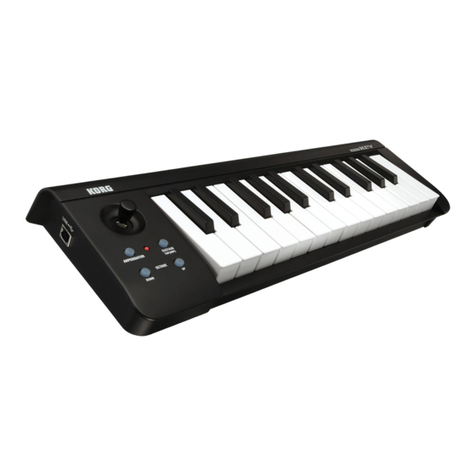
Korg
Korg MICROKEY-25 User manual
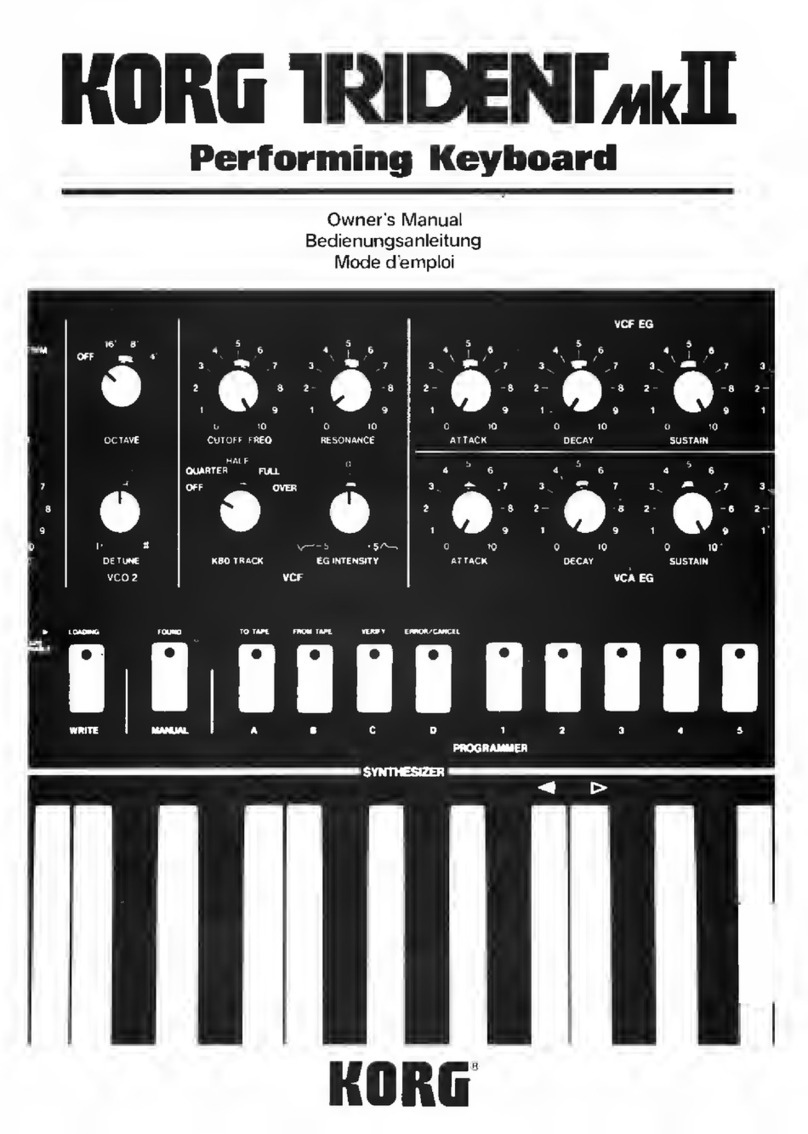
Korg
Korg Trident Mk II User manual
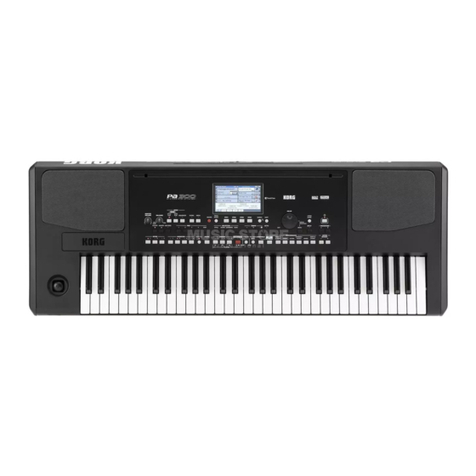
Korg
Korg Pa300 User manual
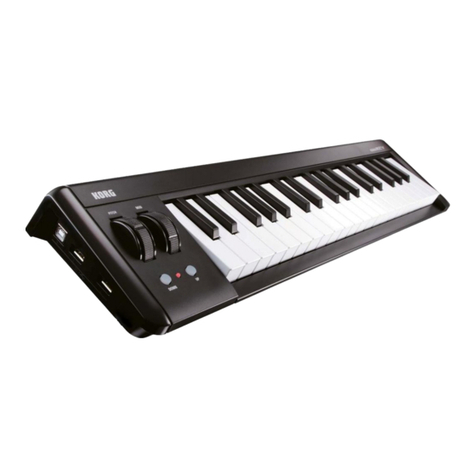
Korg
Korg microkey User manual
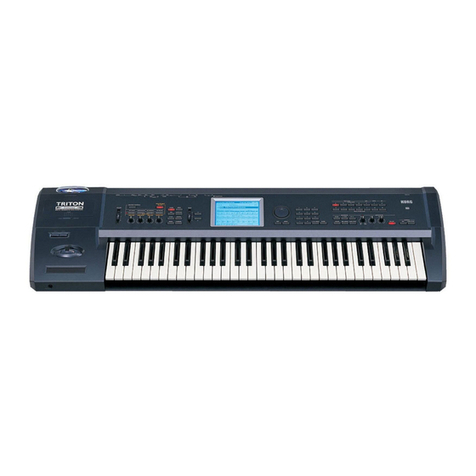
Korg
Korg TRITON Extreme User manual
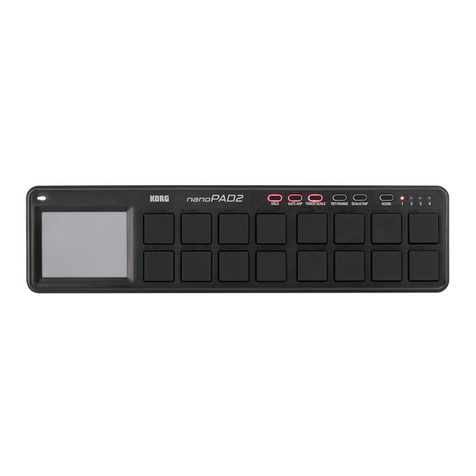
Korg
Korg nanoPad2 User manual
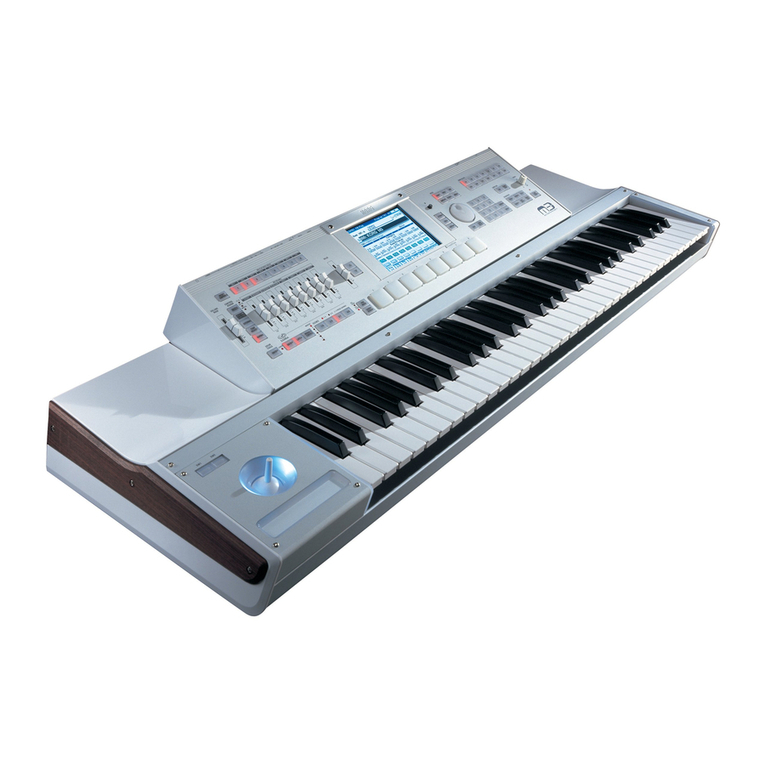
Korg
Korg M3 User manual

Korg
Korg Concert-800 User manual
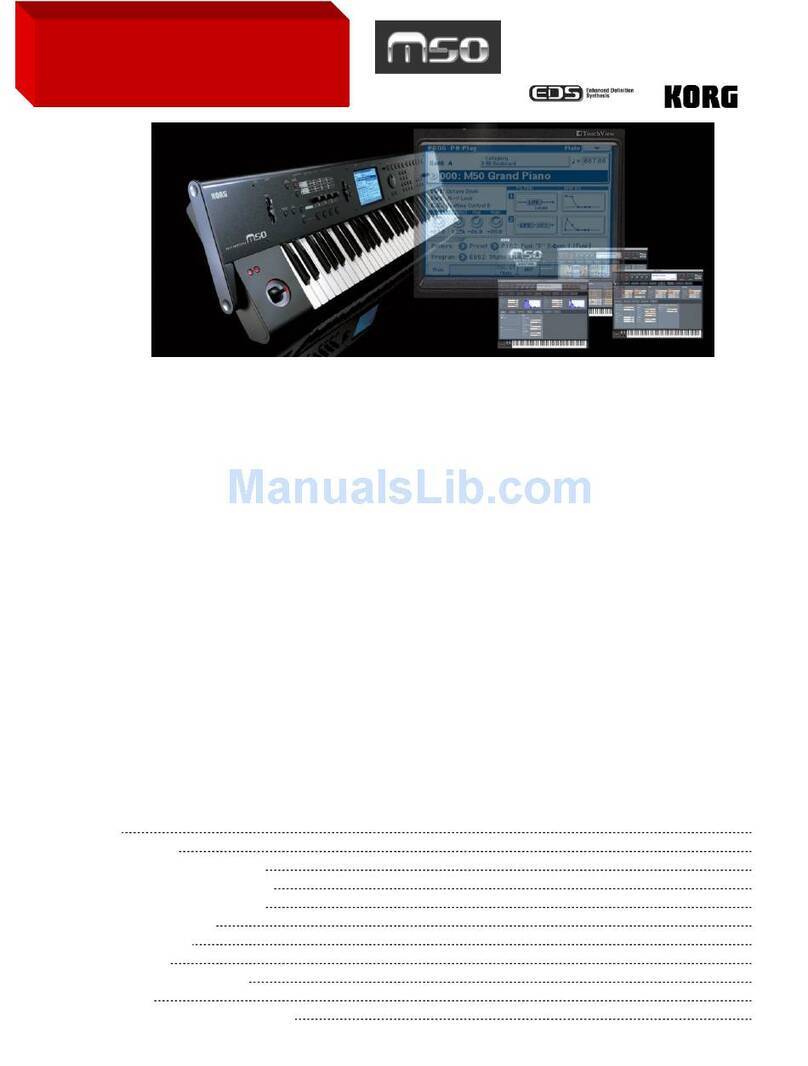
Korg
Korg EASYSTART M50 Product information sheet
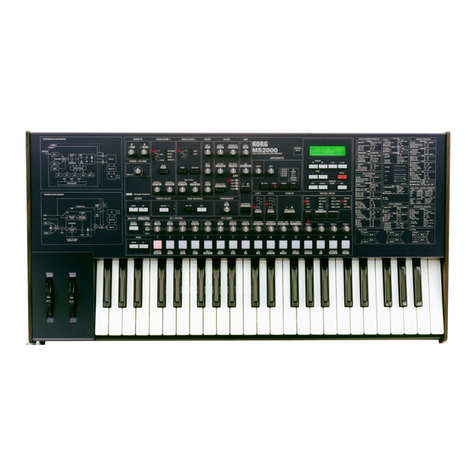
Korg
Korg MS2000 User manual

